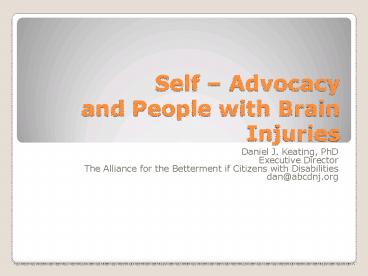Self - PowerPoint PPT Presentation
1 / 21
Title: Self
1
Self Advocacyand People with Brain Injuries
- Daniel J. Keating, PhD
- Executive Director
- The Alliance for the Betterment if Citizens with
Disabilities - dan_at_abcdnj.org
2
World Health Organization Interaction of
Concepts ICF 2001
Health Condition (disorder/disease)
3
Self-Advocacy
- Important in rehabilitation and recovery
- Can affect physical health
- Can affect emotional health
- Can impact quality of life
- Empowers
4
What is Self-Advocacy?
- Advocacy can mean many things, but in general,
it refers to taking action. Advocacy simply
involves speaking and acting on behalf of your
self or others. - Advocacy Tool Kit Skills and Strategies for
Effective Self and Peer Advocacy Disability
Rights Wisconsin, 2008, www.disabilityrightswi.org
5
What is Self-Advocacy?
- Advocacy is a type of problem solving designed
to protect personal, and legal rights, and to
insure a diversified existence. - Advocacy Skills Brain Injury Resource Center
www.headinjury.com/advocacy.htm
6
What is Self-Advocacy?
- There are several types of action that a person
can take - System advocacy taking actions to influence
social, political, and economic systems to bring
about change for groups of people - Legal advocacy what lawyers do to establish or
protect legal rights - Legislative advocacy change laws, promote new
laws - Peer advocacy taking actions to represent the
rights and interests of someone other than
yourself - Self-advocacy taking action to represent and
advance your own interests - Advocacy Skills Brain Injury Resource Center
www.headinjury.com/advocacy.htm
7
What is Self-Advocacy?
- Individual self-advocacy speaking or acting for
oneself and deciding what is best for the
individual and taking charge of ones life by
standing up for oneself. - Group self-advocacy individuals join together to
advocate for a common cause Groups can become
social outlets for people with disabilities - Brandt, J. Creating a New Self-Advocacy
Organization Imagine the Possibilities,
Partnership for People with Disabilities,
Virginia Commonwealth University.
8
What is Self-Advocacy?
- People withdisabilities must be able to act as
self-advocates, that is to exercise their rights
of basic personhood and citizenship by speaking
and standing up for themselves. This means that
people must have a voice in decision-making in
all areas of their daily life and in public
policy decisions affecting them. - Self-Advocacy, The Arc of the United States,
px?piwww.thearc.org/page.asd2358
9
Advocacy Skills
- Self advocacy skills can help you avoid or solve
problems with family and loved ones, doctors and
lawyers, employers, associates, and friends - Advocacy Skills Brain Injury Resource Center
www.headinjury.com/advocacy.htm
10
Advocacy Skills
- Self-advocacy skills can help you obtain
reasonable and necessary accommodations in both
public and private settings i.e., education,
housing, employment, transportation, and
taxation. - Advocacy Skills Brain Injury Resource Center
www.headinjury.com/advocacy.htm
11
Advocacy Skills
- Self-advocacy skills can help you identify,
analyze, and make informed decisions concerning
choices one must make. The regular exercise of
self-advocacy skills can empower one to gain
greater control over ones life. - Advocacy Skills Brain Injury Resource Center
www.headinjury.com/advocacy.htm
12
Self-Advocacy Plan
- Effective advocacy of any kind requires building
a solid strategy or plan and practicing skills to
help you feel comfortable and confident in
reaching your advocacy goals. - Advocacy Training Manual Wisconsin Coalition for
Advocacy, 1986
13
Self-Advocacy Plan
- Break Down the problem
- Educate yourself
- Identify your rights
- Develop a solution (goal) and strategy to address
your problem - Advocacy Training Manual Wisconsin Coalition for
Advocacy, 1986
14
Self-Advocacy Skills
- Educate oneself about your condition
- Keep good records
- Problem solve
- Keep a positive attitude
- Be Persistent
- Thank those who help you
- Advocacy Skills Brain Injury Resource Center
www.headinjury.com/advocacy.htm
15
Advocacy Plan
- Create a Plan
- Statement of the problem
- What would you like to achieve?
- A statement of general purpose or intent
16
Advocacy Plan
- What would you like to achieve?
- What are your goals?
- What is the ideal solution
- What are compromise solutions
17
Advocacy Plan
- Information available
- What Information do you have?
- What information do you need?
18
Advocacy Plan
- Arguments
- What are the arguments that are pro your
position? - What are the arguments that are con your position?
19
Advocacy Plan
- Step by Step Plan
- Who will do what
- What will you do?
- What will other do?
- When will things be done by?
- Establish dates and deadlines
20
Advocacy Plan
- What will you do next if you succeed?
- What will you do if you do not succeed?
21
Conclusion
- Questions
- ???































